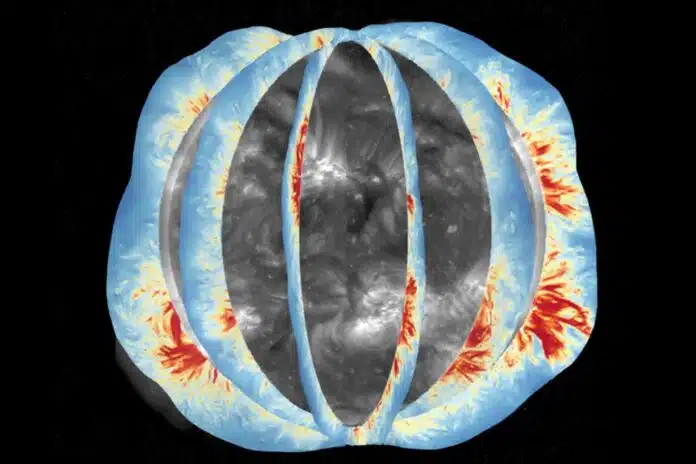
By Pranjal Malewar 7 Oct, 2024
Collected at: https://www.techexplorist.com/global-maps-coronal-magnetic-field/90791/
For the first time, scientists have conducted near-daily measurements of the Sun’s global coronal magnetic field, a region that has historically been observed only sporadically. This continuous data collection was carried out over eight months using the Upgraded Coronal Multi-channel Polarimeter (UCoMP). The study offers valuable insights into the processes driving intense solar storms, which significantly affect technologies on Earth.
The solar magnetic field is critical in forming these storms, posing risks to power grids, communication systems, and technologies like GPS. However, previous efforts to understand how the magnetic field accumulates energy and triggers eruptions have been hampered by the difficulty of observing the solar corona, the Sun’s upper atmosphere.
Measuring the solar corona’s magnetism has traditionally required large, costly equipment capable of studying only small segments of this region. However, by combining coronal seismology with UCoMP observations, scientists can now create consistent and comprehensive images of the corona’s global magnetic field, akin to the whole-sun view seen during a solar eclipse.
This advancement enhances our understanding of the solar magnetic field and its dynamics.
Zihao Yang, the lead author who pursued this research as a PhD graduate at Peking University, China, said, “Global mapping of the coronal magnetic field has been a big missing part in studying the Sun. This research is helping us fill a crucial gap in our understanding of coronal magnetic fields, the energy source for storms that can impact Earth.”
Until now, scientists have been able to measure the magnetic field on the Sun’s photosphere regularly. However, it has been challenging for them to capture the much dimmer coronal magnetic field.
This difficulty has hindered a comprehensive understanding of the three-dimensional structure and evolution of the corona, where solar storms develop. Large telescopes like the NSF’s Daniel K. Inouye Solar Telescope (DKIST) are required to measure these coronal magnetic fields in detail. DKIST, the world’s largest solar telescope with a 4-meter aperture, has recently demonstrated its capability for detailed observations of the coronal magnetic field.
However, it cannot map the entire Sun simultaneously. In contrast, the smaller UCoMP instrument excels at providing global views of the coronal magnetic field, albeit at lower resolution and in a two-dimensional projection. Together, observations from both instruments offer complementary insights for a holistic understanding of the coronal magnetic field.
UCoMP is mainly a coronagraph that uses a disc to block out light from the Sun, making it easier to observe the corona. The instrument also combines a Stokes polarimeter, which images other spectral information such as coronal line intensity and Doppler velocity. Even though UCoMP has a much smaller aperture (20 cm), it can take a wider view, which makes it possible to study the entire Sun on most days.
Using coronal seismology, the team tracked magnetohydrodynamic (MHD) transverse waves in the UCoMP data. The MHD waves gave them information that enabled them to create a two-dimensional map of the strength and direction of the coronal magnetic field.
The observations from the UCoMP also produced the first measurements of the coronal magnetic field in the Sun’s polar regions, which have never been directly observed due to their position beyond our view from Earth.
While the researchers couldn’t visually access the poles, they successfully measured the magnetic emissions emanating from them, aided by improved data quality from UCoMP and the Sun’s near solar maximum. This condition enhanced the typically weak emissions from the polar regions, making obtaining coronal magnetic field results easier.
Yang, a postdoctoral fellow at NSF NCAR, will continue his research on the Sun’s magnetic field. He aims to enhance existing coronal models based on photospheric measurements. Since the current UCoMP method is limited to two dimensions, it doesn’t fully capture the magnetic field’s three-dimensional nature.
Yang and his team plan to integrate their research with other techniques to better understand the complete vector of the magnetic field in the corona.
The third dimension, particularly the orientation along a viewer’s line of sight, is crucial for understanding how the corona is energized before solar eruptions. Combining a large telescope and a global field of view is essential to measure the intricate three-dimensional structures behind solar phenomena.
This goal motivates the development of the proposed Coronal Solar Magnetism Observatory (COSMO), a 1.5-meter-diameter solar refracting telescope currently in its final design study.
Sarah Gibson, COSMO Development Lead and an NSF NCAR scientist co-author on the paper, said, “Since coronal magnetism is the force that sends mass from the Sun flying across the solar system, we have to observe it in 3D — and everywhere all at once, throughout the global corona. Yang’s work represents a huge step forward in our ability to understand how the Sun’s global coronal magnetic field changes from day to day. This is critical to our ability to better predict and prepare for solar storms, an ever-increasing danger to our ever-more technologically dependent lives here on Earth.”
Journal Reference:
- Zihao Yang, Hui Tian, Steven Tomczyk, Xianyu Liu, Sarah Gibson, Richard J. Morton, and Cooper Downs. Observing the evolution of the Sun’s global coronal magnetic field over eight months. Science. DOI: 10.1126/science.ado2993

Leave a Reply